International marketing management of The Brewie Company
VerifiedAdded on 2022/09/09
|10
|2201
|21
AI Summary
Contribute Materials
Your contribution can guide someone’s learning journey. Share your
documents today.
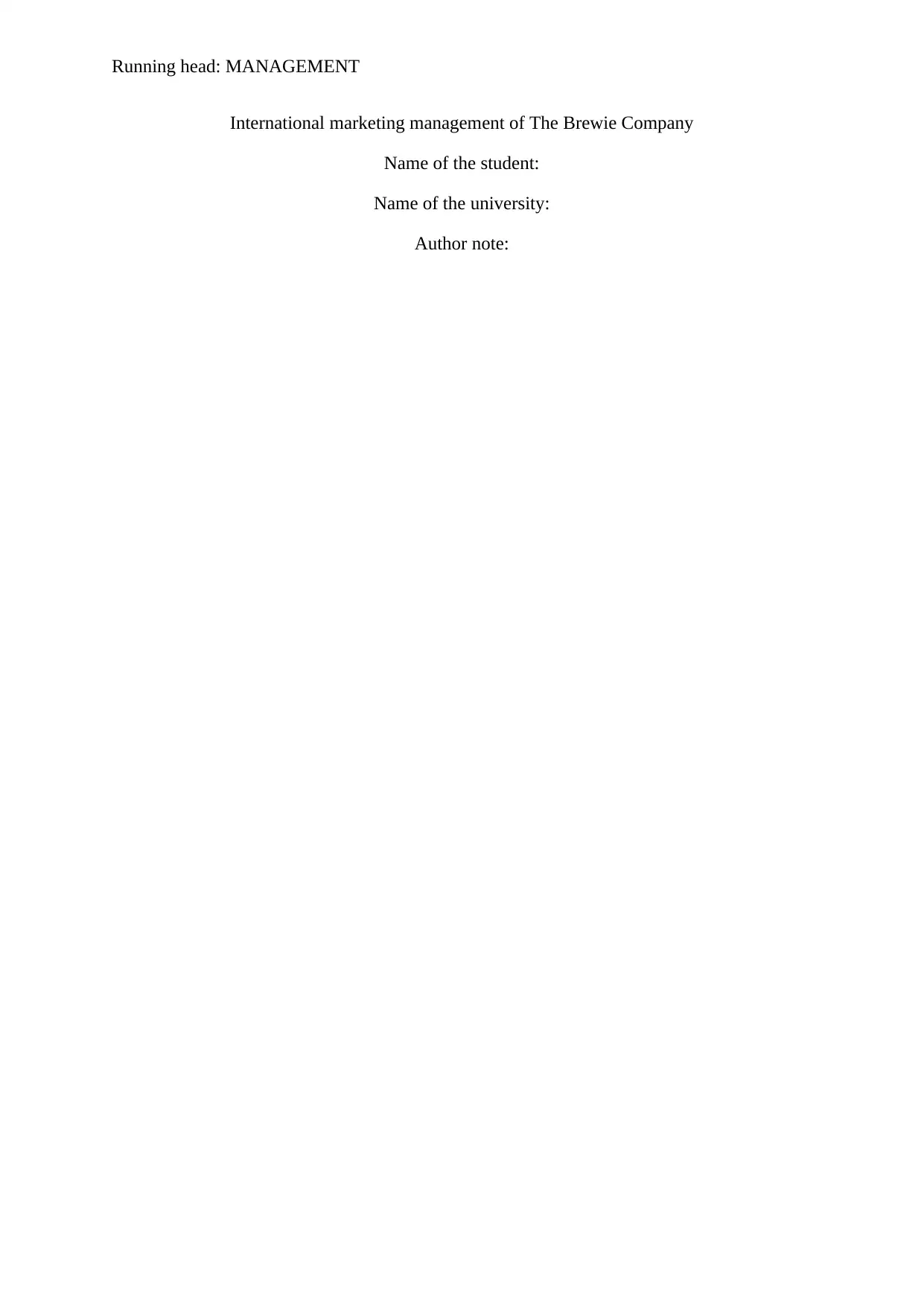
Running head: MANAGEMENT
International marketing management of The Brewie Company
Name of the student:
Name of the university:
Author note:
International marketing management of The Brewie Company
Name of the student:
Name of the university:
Author note:
Secure Best Marks with AI Grader
Need help grading? Try our AI Grader for instant feedback on your assignments.
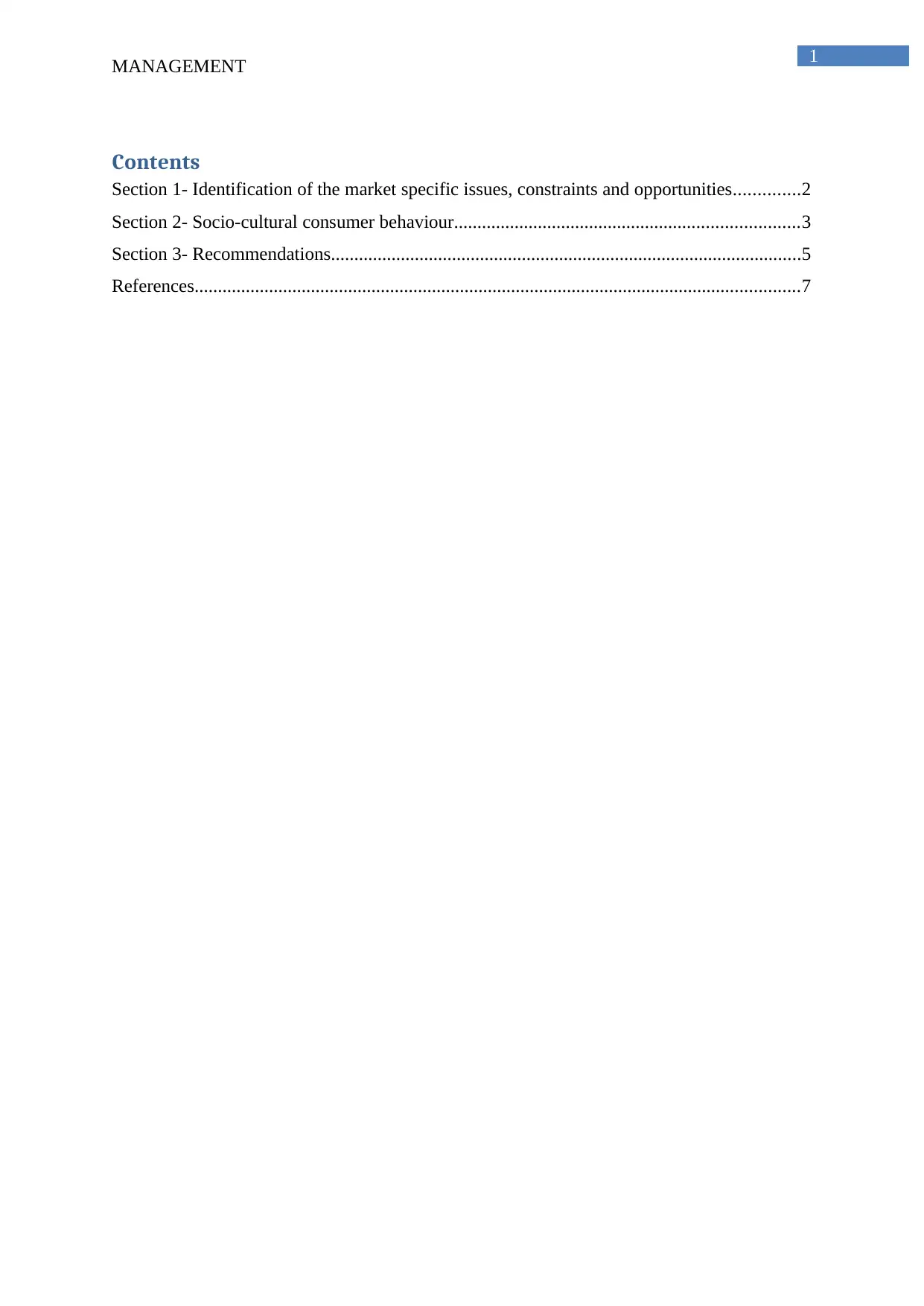
1
MANAGEMENT
Contents
Section 1- Identification of the market specific issues, constraints and opportunities..............2
Section 2- Socio-cultural consumer behaviour..........................................................................3
Section 3- Recommendations.....................................................................................................5
References..................................................................................................................................7
MANAGEMENT
Contents
Section 1- Identification of the market specific issues, constraints and opportunities..............2
Section 2- Socio-cultural consumer behaviour..........................................................................3
Section 3- Recommendations.....................................................................................................5
References..................................................................................................................................7
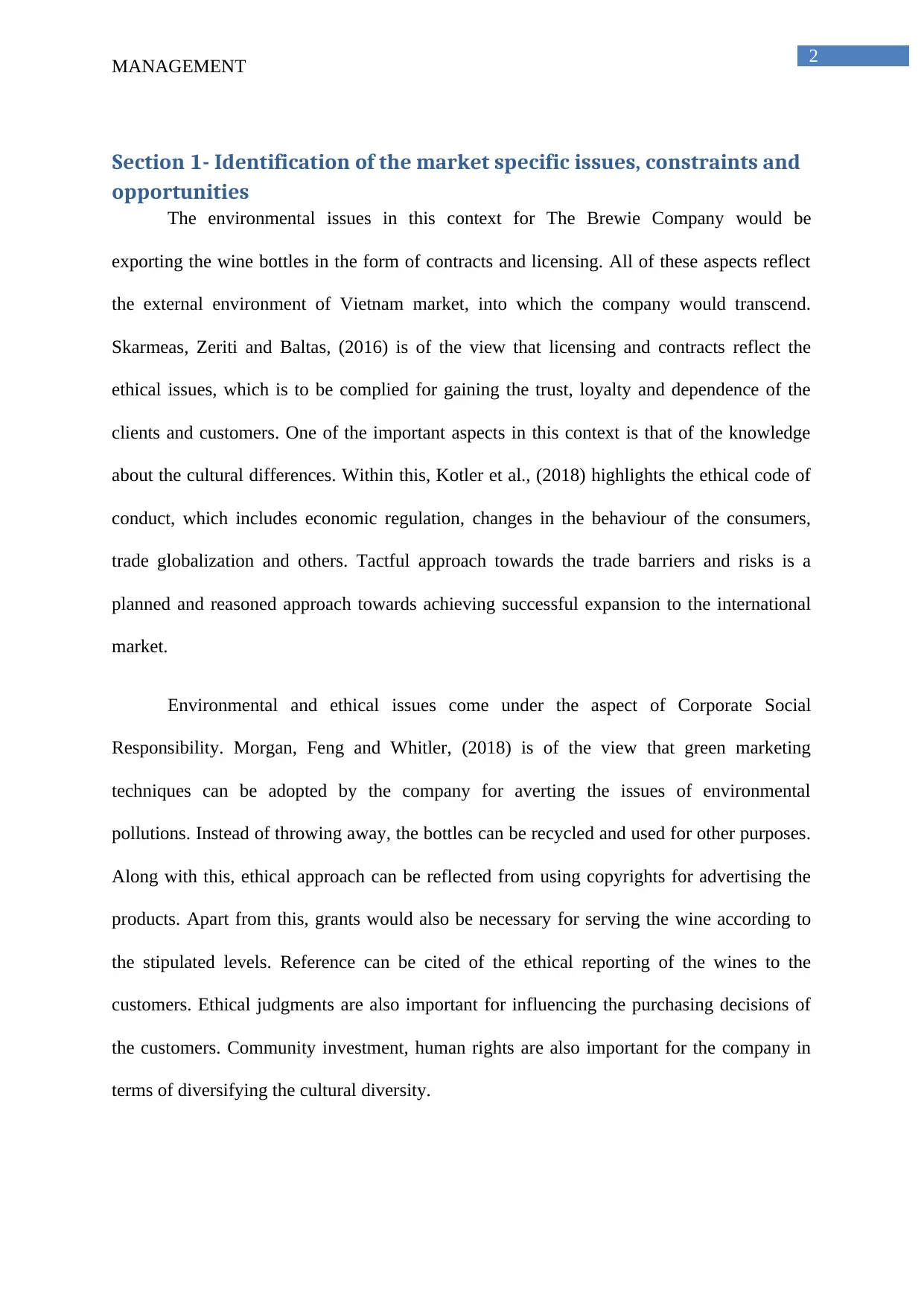
2
MANAGEMENT
Section 1- Identification of the market specific issues, constraints and
opportunities
The environmental issues in this context for The Brewie Company would be
exporting the wine bottles in the form of contracts and licensing. All of these aspects reflect
the external environment of Vietnam market, into which the company would transcend.
Skarmeas, Zeriti and Baltas, (2016) is of the view that licensing and contracts reflect the
ethical issues, which is to be complied for gaining the trust, loyalty and dependence of the
clients and customers. One of the important aspects in this context is that of the knowledge
about the cultural differences. Within this, Kotler et al., (2018) highlights the ethical code of
conduct, which includes economic regulation, changes in the behaviour of the consumers,
trade globalization and others. Tactful approach towards the trade barriers and risks is a
planned and reasoned approach towards achieving successful expansion to the international
market.
Environmental and ethical issues come under the aspect of Corporate Social
Responsibility. Morgan, Feng and Whitler, (2018) is of the view that green marketing
techniques can be adopted by the company for averting the issues of environmental
pollutions. Instead of throwing away, the bottles can be recycled and used for other purposes.
Along with this, ethical approach can be reflected from using copyrights for advertising the
products. Apart from this, grants would also be necessary for serving the wine according to
the stipulated levels. Reference can be cited of the ethical reporting of the wines to the
customers. Ethical judgments are also important for influencing the purchasing decisions of
the customers. Community investment, human rights are also important for the company in
terms of diversifying the cultural diversity.
MANAGEMENT
Section 1- Identification of the market specific issues, constraints and
opportunities
The environmental issues in this context for The Brewie Company would be
exporting the wine bottles in the form of contracts and licensing. All of these aspects reflect
the external environment of Vietnam market, into which the company would transcend.
Skarmeas, Zeriti and Baltas, (2016) is of the view that licensing and contracts reflect the
ethical issues, which is to be complied for gaining the trust, loyalty and dependence of the
clients and customers. One of the important aspects in this context is that of the knowledge
about the cultural differences. Within this, Kotler et al., (2018) highlights the ethical code of
conduct, which includes economic regulation, changes in the behaviour of the consumers,
trade globalization and others. Tactful approach towards the trade barriers and risks is a
planned and reasoned approach towards achieving successful expansion to the international
market.
Environmental and ethical issues come under the aspect of Corporate Social
Responsibility. Morgan, Feng and Whitler, (2018) is of the view that green marketing
techniques can be adopted by the company for averting the issues of environmental
pollutions. Instead of throwing away, the bottles can be recycled and used for other purposes.
Along with this, ethical approach can be reflected from using copyrights for advertising the
products. Apart from this, grants would also be necessary for serving the wine according to
the stipulated levels. Reference can be cited of the ethical reporting of the wines to the
customers. Ethical judgments are also important for influencing the purchasing decisions of
the customers. Community investment, human rights are also important for the company in
terms of diversifying the cultural diversity.
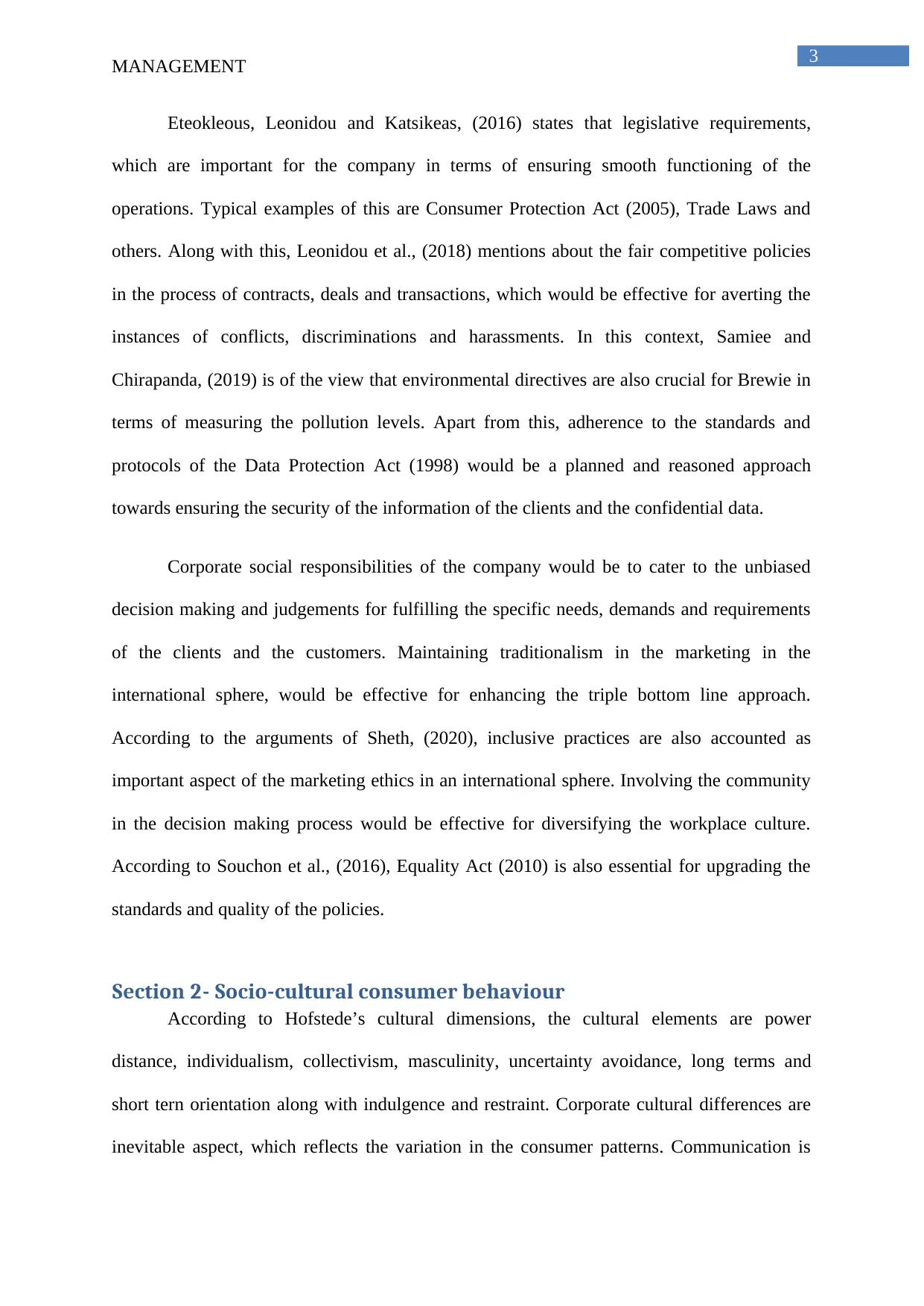
3
MANAGEMENT
Eteokleous, Leonidou and Katsikeas, (2016) states that legislative requirements,
which are important for the company in terms of ensuring smooth functioning of the
operations. Typical examples of this are Consumer Protection Act (2005), Trade Laws and
others. Along with this, Leonidou et al., (2018) mentions about the fair competitive policies
in the process of contracts, deals and transactions, which would be effective for averting the
instances of conflicts, discriminations and harassments. In this context, Samiee and
Chirapanda, (2019) is of the view that environmental directives are also crucial for Brewie in
terms of measuring the pollution levels. Apart from this, adherence to the standards and
protocols of the Data Protection Act (1998) would be a planned and reasoned approach
towards ensuring the security of the information of the clients and the confidential data.
Corporate social responsibilities of the company would be to cater to the unbiased
decision making and judgements for fulfilling the specific needs, demands and requirements
of the clients and the customers. Maintaining traditionalism in the marketing in the
international sphere, would be effective for enhancing the triple bottom line approach.
According to the arguments of Sheth, (2020), inclusive practices are also accounted as
important aspect of the marketing ethics in an international sphere. Involving the community
in the decision making process would be effective for diversifying the workplace culture.
According to Souchon et al., (2016), Equality Act (2010) is also essential for upgrading the
standards and quality of the policies.
Section 2- Socio-cultural consumer behaviour
According to Hofstede’s cultural dimensions, the cultural elements are power
distance, individualism, collectivism, masculinity, uncertainty avoidance, long terms and
short tern orientation along with indulgence and restraint. Corporate cultural differences are
inevitable aspect, which reflects the variation in the consumer patterns. Communication is
MANAGEMENT
Eteokleous, Leonidou and Katsikeas, (2016) states that legislative requirements,
which are important for the company in terms of ensuring smooth functioning of the
operations. Typical examples of this are Consumer Protection Act (2005), Trade Laws and
others. Along with this, Leonidou et al., (2018) mentions about the fair competitive policies
in the process of contracts, deals and transactions, which would be effective for averting the
instances of conflicts, discriminations and harassments. In this context, Samiee and
Chirapanda, (2019) is of the view that environmental directives are also crucial for Brewie in
terms of measuring the pollution levels. Apart from this, adherence to the standards and
protocols of the Data Protection Act (1998) would be a planned and reasoned approach
towards ensuring the security of the information of the clients and the confidential data.
Corporate social responsibilities of the company would be to cater to the unbiased
decision making and judgements for fulfilling the specific needs, demands and requirements
of the clients and the customers. Maintaining traditionalism in the marketing in the
international sphere, would be effective for enhancing the triple bottom line approach.
According to the arguments of Sheth, (2020), inclusive practices are also accounted as
important aspect of the marketing ethics in an international sphere. Involving the community
in the decision making process would be effective for diversifying the workplace culture.
According to Souchon et al., (2016), Equality Act (2010) is also essential for upgrading the
standards and quality of the policies.
Section 2- Socio-cultural consumer behaviour
According to Hofstede’s cultural dimensions, the cultural elements are power
distance, individualism, collectivism, masculinity, uncertainty avoidance, long terms and
short tern orientation along with indulgence and restraint. Corporate cultural differences are
inevitable aspect, which reflects the variation in the consumer patterns. Communication is
Secure Best Marks with AI Grader
Need help grading? Try our AI Grader for instant feedback on your assignments.
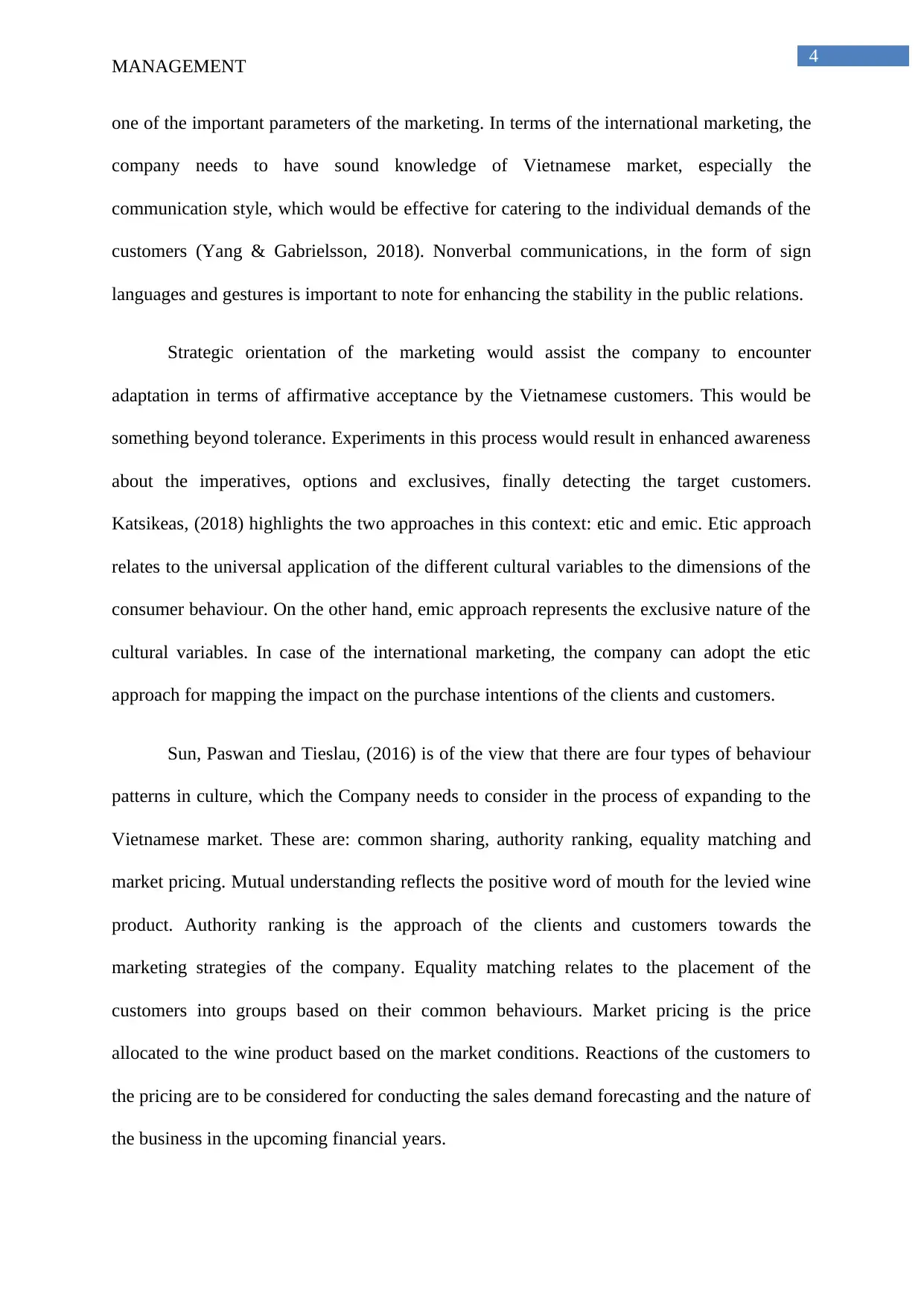
4
MANAGEMENT
one of the important parameters of the marketing. In terms of the international marketing, the
company needs to have sound knowledge of Vietnamese market, especially the
communication style, which would be effective for catering to the individual demands of the
customers (Yang & Gabrielsson, 2018). Nonverbal communications, in the form of sign
languages and gestures is important to note for enhancing the stability in the public relations.
Strategic orientation of the marketing would assist the company to encounter
adaptation in terms of affirmative acceptance by the Vietnamese customers. This would be
something beyond tolerance. Experiments in this process would result in enhanced awareness
about the imperatives, options and exclusives, finally detecting the target customers.
Katsikeas, (2018) highlights the two approaches in this context: etic and emic. Etic approach
relates to the universal application of the different cultural variables to the dimensions of the
consumer behaviour. On the other hand, emic approach represents the exclusive nature of the
cultural variables. In case of the international marketing, the company can adopt the etic
approach for mapping the impact on the purchase intentions of the clients and customers.
Sun, Paswan and Tieslau, (2016) is of the view that there are four types of behaviour
patterns in culture, which the Company needs to consider in the process of expanding to the
Vietnamese market. These are: common sharing, authority ranking, equality matching and
market pricing. Mutual understanding reflects the positive word of mouth for the levied wine
product. Authority ranking is the approach of the clients and customers towards the
marketing strategies of the company. Equality matching relates to the placement of the
customers into groups based on their common behaviours. Market pricing is the price
allocated to the wine product based on the market conditions. Reactions of the customers to
the pricing are to be considered for conducting the sales demand forecasting and the nature of
the business in the upcoming financial years.
MANAGEMENT
one of the important parameters of the marketing. In terms of the international marketing, the
company needs to have sound knowledge of Vietnamese market, especially the
communication style, which would be effective for catering to the individual demands of the
customers (Yang & Gabrielsson, 2018). Nonverbal communications, in the form of sign
languages and gestures is important to note for enhancing the stability in the public relations.
Strategic orientation of the marketing would assist the company to encounter
adaptation in terms of affirmative acceptance by the Vietnamese customers. This would be
something beyond tolerance. Experiments in this process would result in enhanced awareness
about the imperatives, options and exclusives, finally detecting the target customers.
Katsikeas, (2018) highlights the two approaches in this context: etic and emic. Etic approach
relates to the universal application of the different cultural variables to the dimensions of the
consumer behaviour. On the other hand, emic approach represents the exclusive nature of the
cultural variables. In case of the international marketing, the company can adopt the etic
approach for mapping the impact on the purchase intentions of the clients and customers.
Sun, Paswan and Tieslau, (2016) is of the view that there are four types of behaviour
patterns in culture, which the Company needs to consider in the process of expanding to the
Vietnamese market. These are: common sharing, authority ranking, equality matching and
market pricing. Mutual understanding reflects the positive word of mouth for the levied wine
product. Authority ranking is the approach of the clients and customers towards the
marketing strategies of the company. Equality matching relates to the placement of the
customers into groups based on their common behaviours. Market pricing is the price
allocated to the wine product based on the market conditions. Reactions of the customers to
the pricing are to be considered for conducting the sales demand forecasting and the nature of
the business in the upcoming financial years.
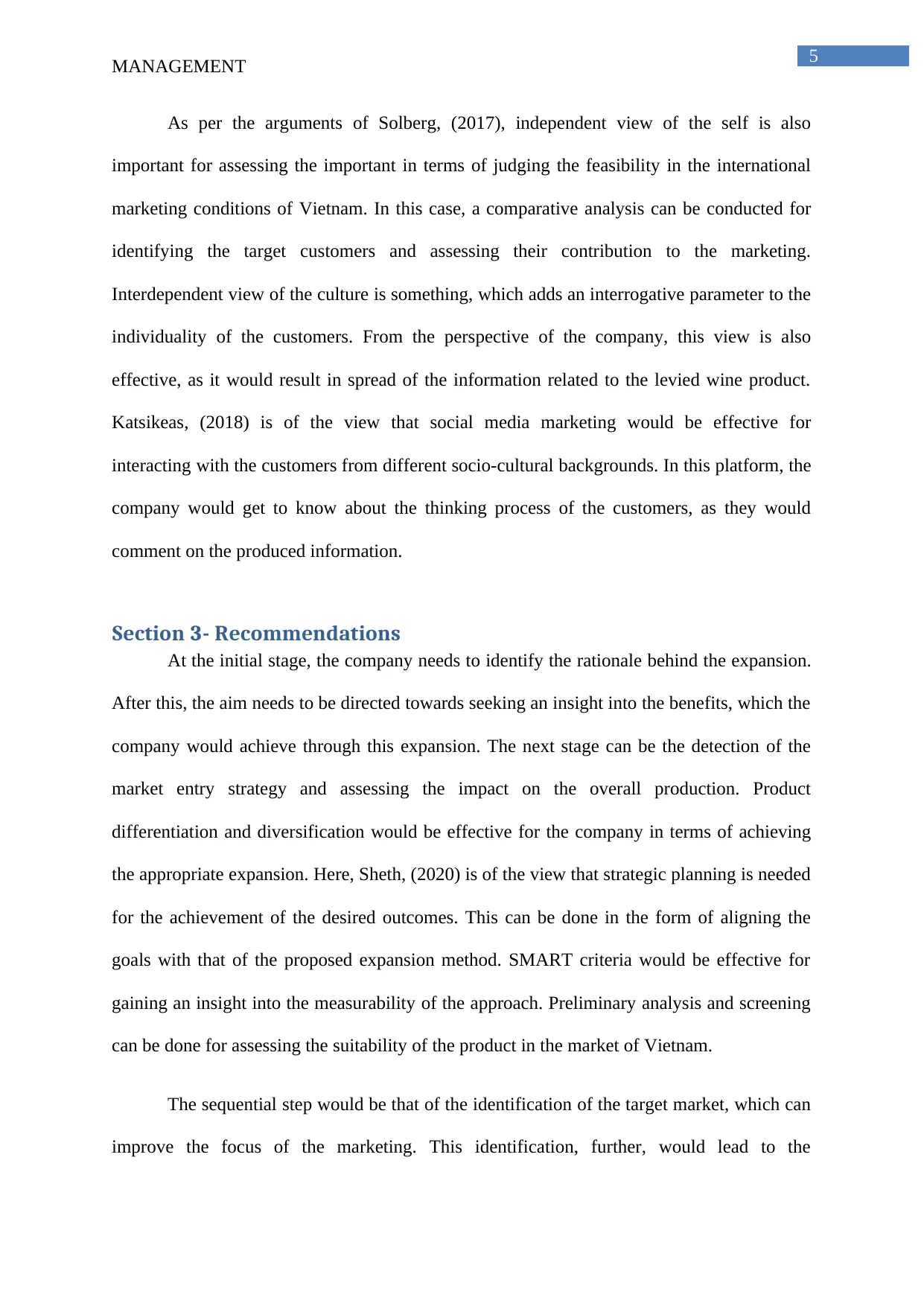
5
MANAGEMENT
As per the arguments of Solberg, (2017), independent view of the self is also
important for assessing the important in terms of judging the feasibility in the international
marketing conditions of Vietnam. In this case, a comparative analysis can be conducted for
identifying the target customers and assessing their contribution to the marketing.
Interdependent view of the culture is something, which adds an interrogative parameter to the
individuality of the customers. From the perspective of the company, this view is also
effective, as it would result in spread of the information related to the levied wine product.
Katsikeas, (2018) is of the view that social media marketing would be effective for
interacting with the customers from different socio-cultural backgrounds. In this platform, the
company would get to know about the thinking process of the customers, as they would
comment on the produced information.
Section 3- Recommendations
At the initial stage, the company needs to identify the rationale behind the expansion.
After this, the aim needs to be directed towards seeking an insight into the benefits, which the
company would achieve through this expansion. The next stage can be the detection of the
market entry strategy and assessing the impact on the overall production. Product
differentiation and diversification would be effective for the company in terms of achieving
the appropriate expansion. Here, Sheth, (2020) is of the view that strategic planning is needed
for the achievement of the desired outcomes. This can be done in the form of aligning the
goals with that of the proposed expansion method. SMART criteria would be effective for
gaining an insight into the measurability of the approach. Preliminary analysis and screening
can be done for assessing the suitability of the product in the market of Vietnam.
The sequential step would be that of the identification of the target market, which can
improve the focus of the marketing. This identification, further, would lead to the
MANAGEMENT
As per the arguments of Solberg, (2017), independent view of the self is also
important for assessing the important in terms of judging the feasibility in the international
marketing conditions of Vietnam. In this case, a comparative analysis can be conducted for
identifying the target customers and assessing their contribution to the marketing.
Interdependent view of the culture is something, which adds an interrogative parameter to the
individuality of the customers. From the perspective of the company, this view is also
effective, as it would result in spread of the information related to the levied wine product.
Katsikeas, (2018) is of the view that social media marketing would be effective for
interacting with the customers from different socio-cultural backgrounds. In this platform, the
company would get to know about the thinking process of the customers, as they would
comment on the produced information.
Section 3- Recommendations
At the initial stage, the company needs to identify the rationale behind the expansion.
After this, the aim needs to be directed towards seeking an insight into the benefits, which the
company would achieve through this expansion. The next stage can be the detection of the
market entry strategy and assessing the impact on the overall production. Product
differentiation and diversification would be effective for the company in terms of achieving
the appropriate expansion. Here, Sheth, (2020) is of the view that strategic planning is needed
for the achievement of the desired outcomes. This can be done in the form of aligning the
goals with that of the proposed expansion method. SMART criteria would be effective for
gaining an insight into the measurability of the approach. Preliminary analysis and screening
can be done for assessing the suitability of the product in the market of Vietnam.
The sequential step would be that of the identification of the target market, which can
improve the focus of the marketing. This identification, further, would lead to the
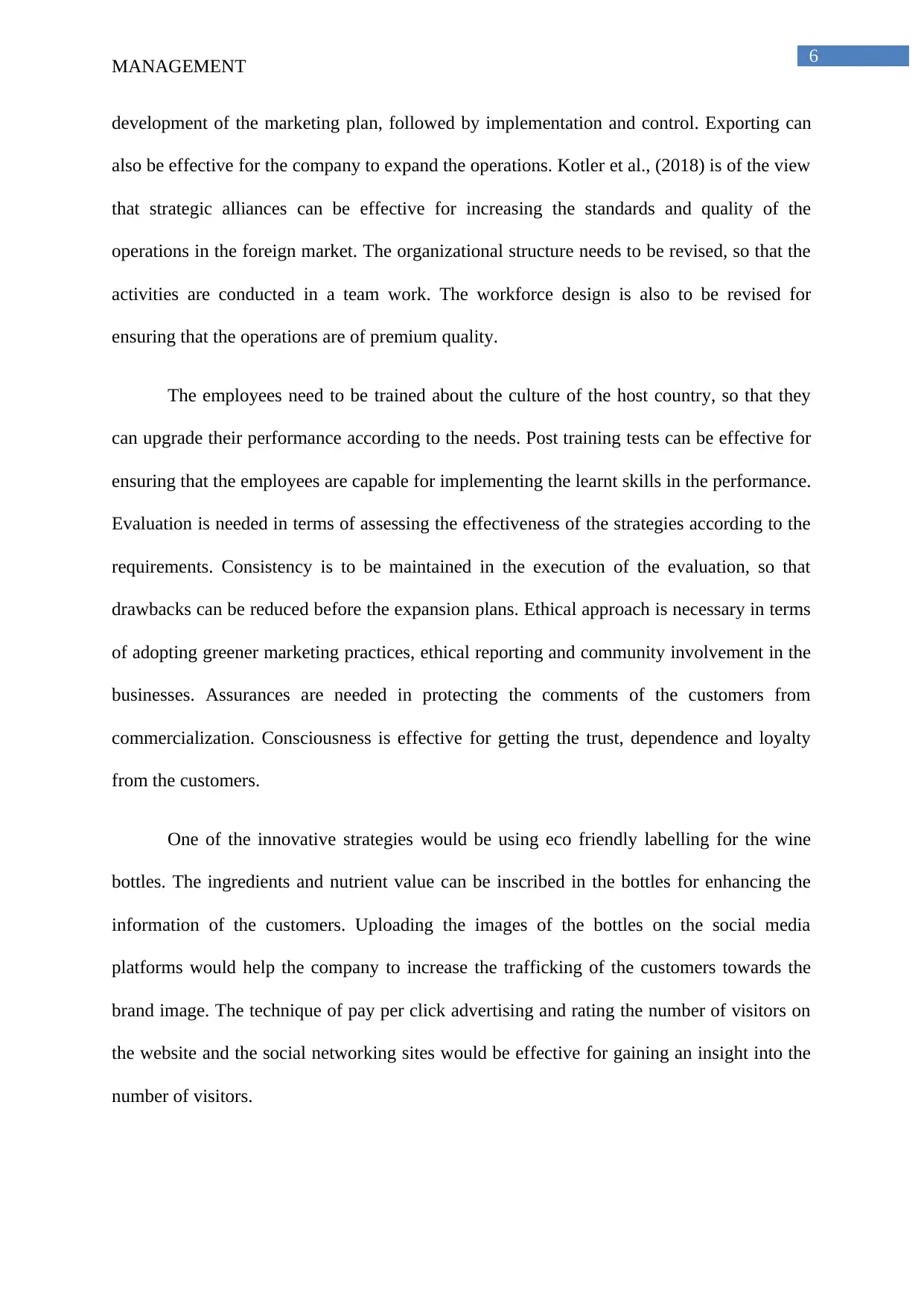
6
MANAGEMENT
development of the marketing plan, followed by implementation and control. Exporting can
also be effective for the company to expand the operations. Kotler et al., (2018) is of the view
that strategic alliances can be effective for increasing the standards and quality of the
operations in the foreign market. The organizational structure needs to be revised, so that the
activities are conducted in a team work. The workforce design is also to be revised for
ensuring that the operations are of premium quality.
The employees need to be trained about the culture of the host country, so that they
can upgrade their performance according to the needs. Post training tests can be effective for
ensuring that the employees are capable for implementing the learnt skills in the performance.
Evaluation is needed in terms of assessing the effectiveness of the strategies according to the
requirements. Consistency is to be maintained in the execution of the evaluation, so that
drawbacks can be reduced before the expansion plans. Ethical approach is necessary in terms
of adopting greener marketing practices, ethical reporting and community involvement in the
businesses. Assurances are needed in protecting the comments of the customers from
commercialization. Consciousness is effective for getting the trust, dependence and loyalty
from the customers.
One of the innovative strategies would be using eco friendly labelling for the wine
bottles. The ingredients and nutrient value can be inscribed in the bottles for enhancing the
information of the customers. Uploading the images of the bottles on the social media
platforms would help the company to increase the trafficking of the customers towards the
brand image. The technique of pay per click advertising and rating the number of visitors on
the website and the social networking sites would be effective for gaining an insight into the
number of visitors.
MANAGEMENT
development of the marketing plan, followed by implementation and control. Exporting can
also be effective for the company to expand the operations. Kotler et al., (2018) is of the view
that strategic alliances can be effective for increasing the standards and quality of the
operations in the foreign market. The organizational structure needs to be revised, so that the
activities are conducted in a team work. The workforce design is also to be revised for
ensuring that the operations are of premium quality.
The employees need to be trained about the culture of the host country, so that they
can upgrade their performance according to the needs. Post training tests can be effective for
ensuring that the employees are capable for implementing the learnt skills in the performance.
Evaluation is needed in terms of assessing the effectiveness of the strategies according to the
requirements. Consistency is to be maintained in the execution of the evaluation, so that
drawbacks can be reduced before the expansion plans. Ethical approach is necessary in terms
of adopting greener marketing practices, ethical reporting and community involvement in the
businesses. Assurances are needed in protecting the comments of the customers from
commercialization. Consciousness is effective for getting the trust, dependence and loyalty
from the customers.
One of the innovative strategies would be using eco friendly labelling for the wine
bottles. The ingredients and nutrient value can be inscribed in the bottles for enhancing the
information of the customers. Uploading the images of the bottles on the social media
platforms would help the company to increase the trafficking of the customers towards the
brand image. The technique of pay per click advertising and rating the number of visitors on
the website and the social networking sites would be effective for gaining an insight into the
number of visitors.
Paraphrase This Document
Need a fresh take? Get an instant paraphrase of this document with our AI Paraphraser

7
MANAGEMENT
MANAGEMENT
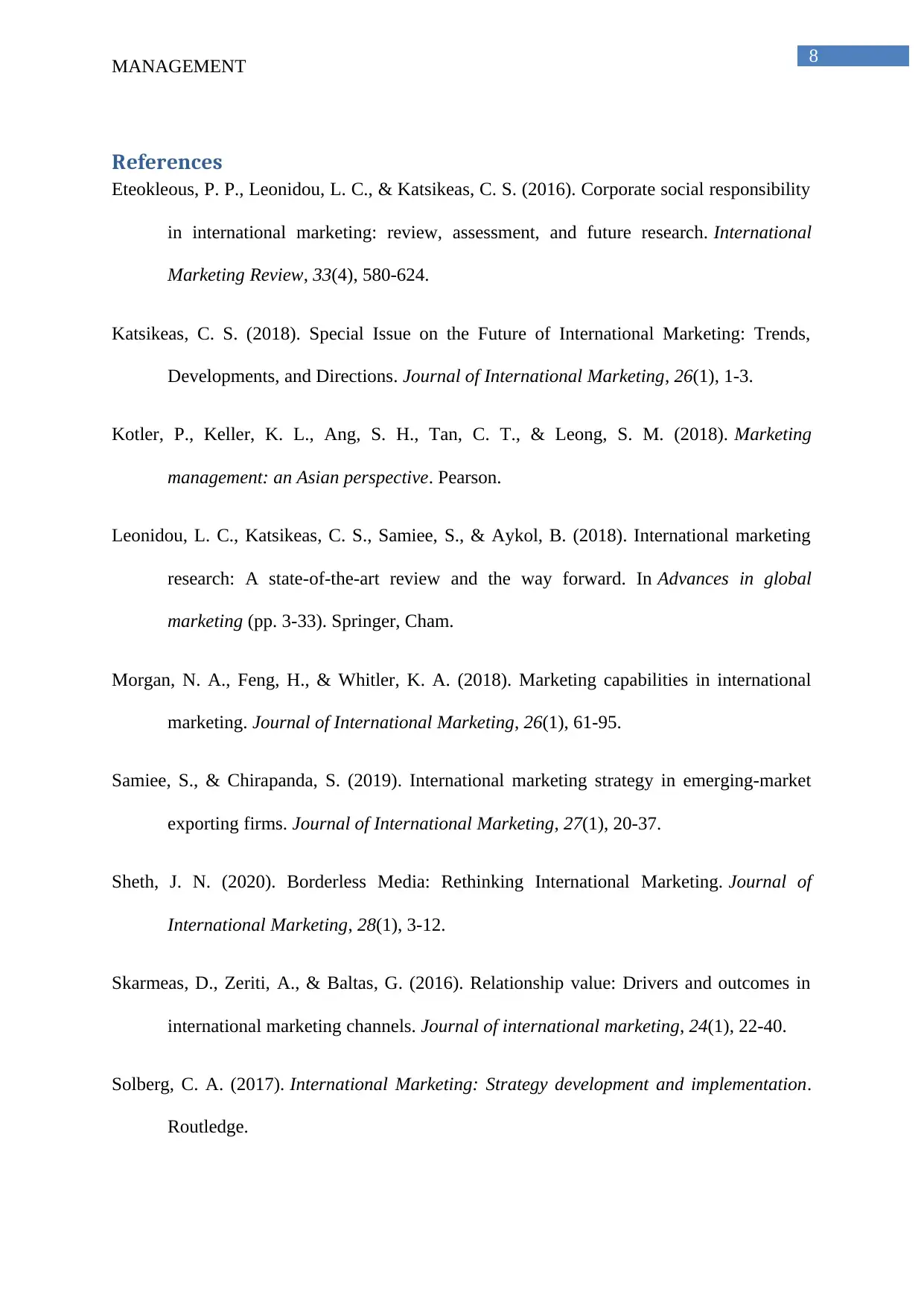
8
MANAGEMENT
References
Eteokleous, P. P., Leonidou, L. C., & Katsikeas, C. S. (2016). Corporate social responsibility
in international marketing: review, assessment, and future research. International
Marketing Review, 33(4), 580-624.
Katsikeas, C. S. (2018). Special Issue on the Future of International Marketing: Trends,
Developments, and Directions. Journal of International Marketing, 26(1), 1-3.
Kotler, P., Keller, K. L., Ang, S. H., Tan, C. T., & Leong, S. M. (2018). Marketing
management: an Asian perspective. Pearson.
Leonidou, L. C., Katsikeas, C. S., Samiee, S., & Aykol, B. (2018). International marketing
research: A state-of-the-art review and the way forward. In Advances in global
marketing (pp. 3-33). Springer, Cham.
Morgan, N. A., Feng, H., & Whitler, K. A. (2018). Marketing capabilities in international
marketing. Journal of International Marketing, 26(1), 61-95.
Samiee, S., & Chirapanda, S. (2019). International marketing strategy in emerging-market
exporting firms. Journal of International Marketing, 27(1), 20-37.
Sheth, J. N. (2020). Borderless Media: Rethinking International Marketing. Journal of
International Marketing, 28(1), 3-12.
Skarmeas, D., Zeriti, A., & Baltas, G. (2016). Relationship value: Drivers and outcomes in
international marketing channels. Journal of international marketing, 24(1), 22-40.
Solberg, C. A. (2017). International Marketing: Strategy development and implementation.
Routledge.
MANAGEMENT
References
Eteokleous, P. P., Leonidou, L. C., & Katsikeas, C. S. (2016). Corporate social responsibility
in international marketing: review, assessment, and future research. International
Marketing Review, 33(4), 580-624.
Katsikeas, C. S. (2018). Special Issue on the Future of International Marketing: Trends,
Developments, and Directions. Journal of International Marketing, 26(1), 1-3.
Kotler, P., Keller, K. L., Ang, S. H., Tan, C. T., & Leong, S. M. (2018). Marketing
management: an Asian perspective. Pearson.
Leonidou, L. C., Katsikeas, C. S., Samiee, S., & Aykol, B. (2018). International marketing
research: A state-of-the-art review and the way forward. In Advances in global
marketing (pp. 3-33). Springer, Cham.
Morgan, N. A., Feng, H., & Whitler, K. A. (2018). Marketing capabilities in international
marketing. Journal of International Marketing, 26(1), 61-95.
Samiee, S., & Chirapanda, S. (2019). International marketing strategy in emerging-market
exporting firms. Journal of International Marketing, 27(1), 20-37.
Sheth, J. N. (2020). Borderless Media: Rethinking International Marketing. Journal of
International Marketing, 28(1), 3-12.
Skarmeas, D., Zeriti, A., & Baltas, G. (2016). Relationship value: Drivers and outcomes in
international marketing channels. Journal of international marketing, 24(1), 22-40.
Solberg, C. A. (2017). International Marketing: Strategy development and implementation.
Routledge.
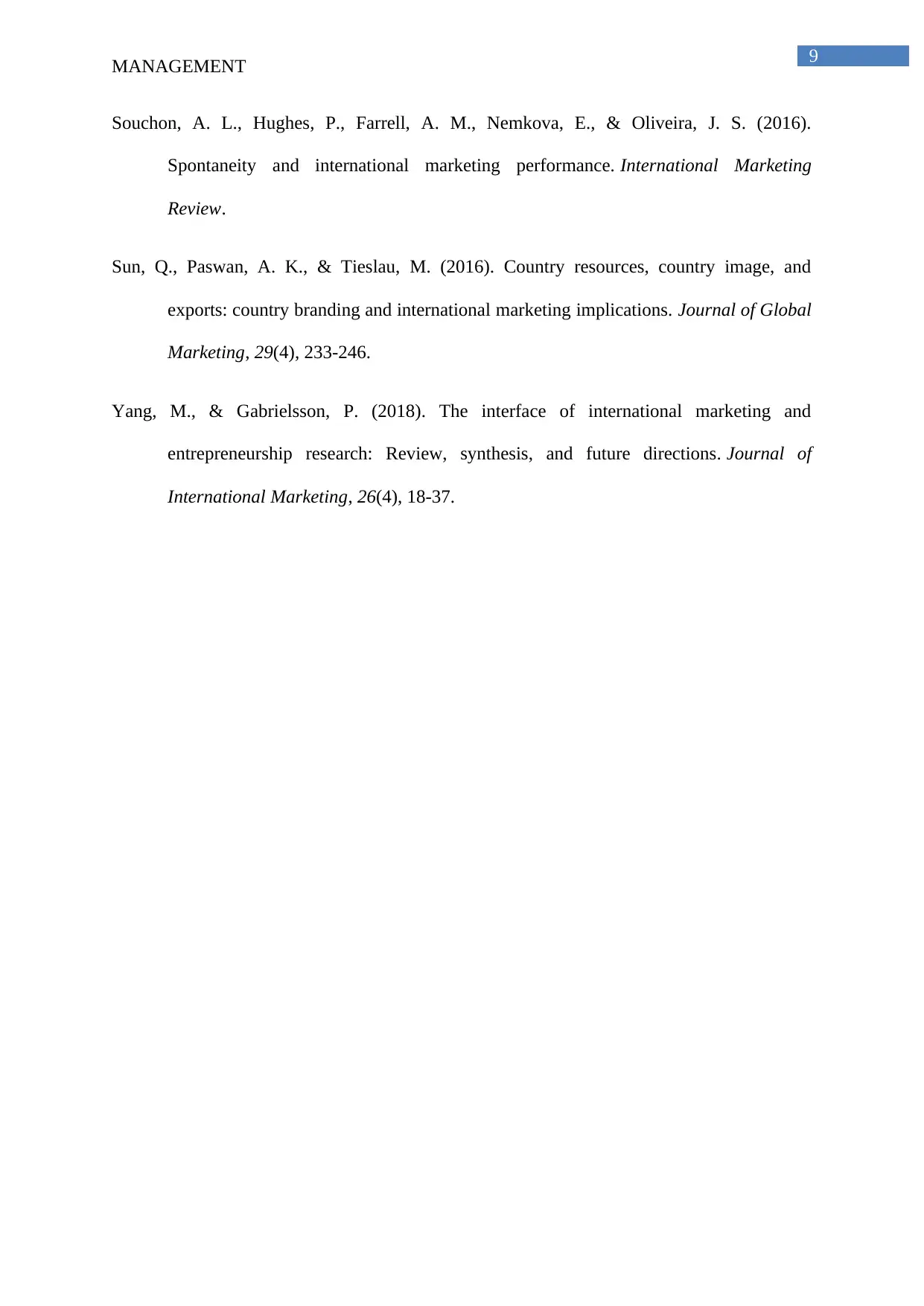
9
MANAGEMENT
Souchon, A. L., Hughes, P., Farrell, A. M., Nemkova, E., & Oliveira, J. S. (2016).
Spontaneity and international marketing performance. International Marketing
Review.
Sun, Q., Paswan, A. K., & Tieslau, M. (2016). Country resources, country image, and
exports: country branding and international marketing implications. Journal of Global
Marketing, 29(4), 233-246.
Yang, M., & Gabrielsson, P. (2018). The interface of international marketing and
entrepreneurship research: Review, synthesis, and future directions. Journal of
International Marketing, 26(4), 18-37.
MANAGEMENT
Souchon, A. L., Hughes, P., Farrell, A. M., Nemkova, E., & Oliveira, J. S. (2016).
Spontaneity and international marketing performance. International Marketing
Review.
Sun, Q., Paswan, A. K., & Tieslau, M. (2016). Country resources, country image, and
exports: country branding and international marketing implications. Journal of Global
Marketing, 29(4), 233-246.
Yang, M., & Gabrielsson, P. (2018). The interface of international marketing and
entrepreneurship research: Review, synthesis, and future directions. Journal of
International Marketing, 26(4), 18-37.
1 out of 10
Related Documents
Your All-in-One AI-Powered Toolkit for Academic Success.
+13062052269
info@desklib.com
Available 24*7 on WhatsApp / Email
![[object Object]](/_next/static/media/star-bottom.7253800d.svg)
Unlock your academic potential
© 2024 | Zucol Services PVT LTD | All rights reserved.




